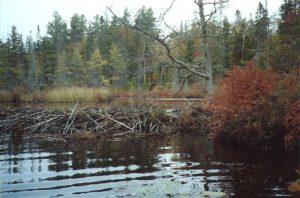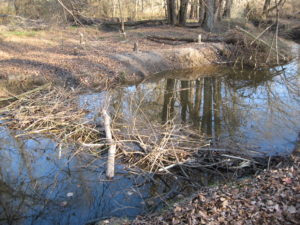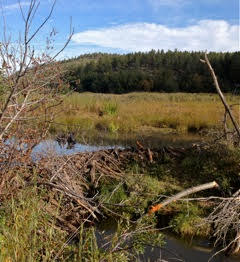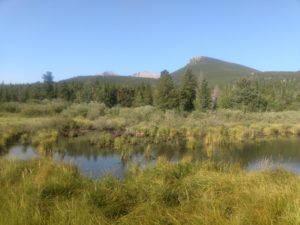Beaver Dam Benefits in Our Environment
Beaver Dams Provide Critical Environmental Benefits
The U.S Fish and Wildlife Service notes that beavers are “one of the most cost effective and sustainable solutions for ecological restoration and climate change resilience.” And yet, in 2017, the U.S Department of Agriculture killed 23,646 beavers. A new approach to beaver management is needed.
Dam That’s Good!

A beaver dam on Long Pond in the Adirondacks in New York. Photo courtesy of Chris Pupke.
The most important environmental aspect of beavers is their ability and drive to build beaver dams. These beaver dams provide tremendous environmental benefits for wildlife, water quality and ground water recharge. The dams slow the flow of water through a stream or other body of water.
Here is some video footage of beavers building a dam and inside their lodge from the PBS Nature program “Leave It To Beavers”: https://www.youtube.com/watch?v=yJjaQExOPPY
The wetland created behind the dam provides great habitat for wildlife, including birds and amphibians. Water quality in the streams downstream improves as sediment and nutrients are filtered in these wetlands. Finally, the water stored behind the dam helps recharge ground water levels by allowing the water to filter down into the ground rather than simply slip by in the stream.
What Biophilia Foundation Does For Beaver Dams:
Recognizing the great environmental benefits beavers provide, Biophilia Foundation is working to protect beaver habitat and imitate the beneficial habitat they create. At our Pritzlaff Ranch, we removed livestock that had denuded a field. The beavers moved in and built a dam resulting in increased habitat and improved water quality.

This small beaver dam was likely built by a young male. Regrettably, it did not last long. It was located on Island Creek near Centreville, MD on land Biophilia Foundation partner Chesapeake Wildlife Heritage helped to permanently protect with a conservation easement. Photo courtesy of Chris Pupke.
Many of our partners work to replicate the beaver’s habitat restoration work. Chesapeake Wildlife Heritage’s work to restore wetlands mimics the beaver dams (see: http://www.cheswildlife.org/2014/08/chic-farm/). In southern Arizona, Borderlands Restoration Network’s placement of gabions in channelized stream beds has many of the same impacts that a beaver dam would have (see: https://www.borderlandsrestoration.org/watershed-and-habitat-restoration.html)
Biophilia believes that a new approach to beaver management is needed throughout the nation. This approach must include allowing beavers to build dams as often as possible and using beaver baffles to reduce conflicts with neighbors. Where beavers are not present, we should carefully consider imitating the habitat they create when they build their dams.
The environmental benefits that beavers provide are critical if we are to allow our environment to recover.
Read More: NYC’s Creative Solution for Clean Water
Description of a Beaver:
Beavers (Castor canadensis) are the largest rodent in North America. They grow between three and four feet in length and typically weigh between 35 and 65 pounds. It has webbed hindfeet that help it swim. Its scale-like tail typically measures twelve inches in length, five inches in width and two inches thick.
One of their most remarkable features is their teeth which are orange and never stop growing. These two odd characteristics relate to how important teeth are to beavers. Maintaining strong healthy teeth is critical for beaver to help build dams and collect food. The teeth never stop growing to prevent daily wear and tear from reducing the teeth to nothing. The red coloration is a result of iron in the teeth which helps strengthen the teeth. These teeth help beavers provide enormous environmental benefits.

This beaver dam was built in a former cow pasture that was denuded of vegetation on Biophilia Foundation’s Pritzlaff Ranch near Sapello, New Mexico. By removing the cattle and allowing the beavers to move in, numerous environmental benefits were realized including increased habitat for wildlife, improved water quality and enhanced ground water recharge. Photo courtesy of Richard Pritzlaff.
Range, Habitat and Population of Beavers:
Beavers occur throughout the United States and Canada. They are present in every state except Hawaii and are only absent in portions of the Florida peninsula, the arid southwest and above the Artic Circle. They even stretch into extreme northern Mexico. Wherever they live, beavers provide environmental benefits.
Beavers need a suitable river, stream, lake or pond to survive. The water should be moving water –the sound of moving water is a critical trigger to beaver’s dam making passion. This includes some desert waterbodies like Susie Creek in the Great Basin desert in northern Nevada. You can read more about the remarkable transformation beavers had on Susie Creek here. The story includes some excellent photographs of Susie Creek before and after the beavers moved in. https://news.medill.northwestern.edu/chicago/battle-born-beaver-tale/
One estimate put the number of beavers in North America before European settlement at as many as 400 million. Other figures suggest a population of roughly 60 million. Recent research suggests a population of approximately 12 million beavers. The densest population of beavers presently known is near the Pasquia Hills in Saskatchewan at an astounding 25 to 40 beavers per square mile.
Related Blog: Mudford Farm Habitat Restoration
Beaver Threats:
Historically, beaver pelts were one of the most important economic drivers in colonial North America. They were prized for felt hats in Europe. Great fortunes were made in beaver trapping -including the Astor family of New York City. By 1900, fur trapping had almost completely extirpated beavers from the eastern United States. Margaret Atwood, the author of “The Handmaid’s Tale”, once quipped, “Canada was built on dead beavers.” With the drop in population, the benefits beavers provided to our environment declined.

It may be surprising to find a beaver in the New York City subway. This beaver adorns the Astor Place subway station in Manhattan. The Astor Family fortune was built on beaver pelts. Photo courtesy of Chris Pupke.
Today the threat of fur trapping has been replaced by aggressive control measures when beaver dams impact local roads, farm fields and residential development. Beavers’ ability to back water up can produce a local problem. There are however non-lethal options such as beaver baffles that can ameliorate the issue.
Furthermore, some anglers complain about beaver dams cutting off fish spawning habitat. For example, the State of Minnesota has aggressively controlled beaver populations to promote populations of steelhead trout –a non-native species of sport fish that was introduced to the state in the 1950’s. This ignores the numerous benefits beavers have on water quality and a wide diversity of wildlife.
Solution to protect beaver dams
Rather than needlessly slaughter beavers whose dams are causing legitimate problems for people, there are other means available to help ensure beavers can co-exist with us. One simple way is to place a beaver baffle in a beaver dam. These baffles allow humans to control the water levels in a beaver pond to ensure the beavers do not flood out homes or roads. Beaver baffles allow us to enjoy the environmental benefits that beavers provide while also preventing flooding from becoming an issue. The Vermont Fish and Wildlife Department has an excellent (and short) video on beaver baffles: https://www.youtube.com/watch?v=msJkDQQkpmI

Beavers face many man-made threats in addition to their natural ones. Unfortunately, the beaver family that created this beaver pond in Rocky Mountain National Park died from a tularemia infection. These natural threats reinforce the need for humans to manage beaver populations in new ways so that we do not lose the important environmental benefits beavers provide. Photo courtesy of Chris Pupke.
Sources:
https://www.aphis.usda.gov/wildlife_damage/pdr/PDR-G_Report.php?fy=2017&fld=&fld_val
Bacckhouse, Frances; Once They Were Hats; ECW Press; Toronto, ON; 2015.
Baker, B.W. and E.P. Hill; “Beaver (Castor canadensis): Wild Mammals of North America”; The Johns Hopkins University Press; Baltimore, MD; 2003.
https://www.fws.gov/oregonfwo/promo.cfm?id=177175812
https://www.nationalgeographic.com/animals/mammals/b/beaver/
https://nationalzoo.si.edu/animals/beaver
https://www.nrri.umn.edu/natural-resources-research-institute/news/beavers
Osborne, Jari; “Leave It To Beavers”; PSB: Nature; Marc Fletcher Productions; Thirteen Productions, Inc.; 2014.

Recent Comments